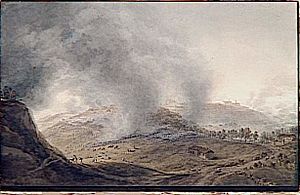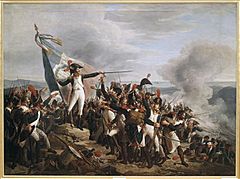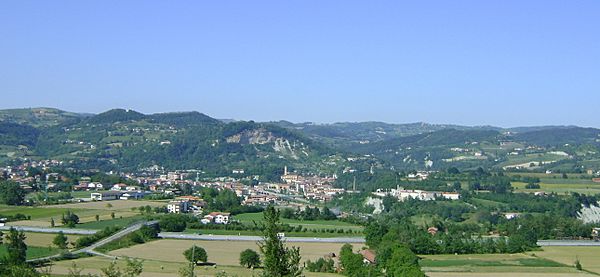Montenotte campaign facts for kids
Quick facts for kids Montenotte campaign |
|||||||
|---|---|---|---|---|---|---|---|
| Part of the Italian campaigns in the War of the First Coalition | |||||||
 View of the Battle of Mondovi by Giuseppe Pietro Bagetti (1764-1831) |
|||||||
|
|||||||
| Belligerents | |||||||
| Commanders and leaders | |||||||
| Strength | |||||||
| 67,000 total | |||||||
| Casualties and losses | |||||||
| 25,000 total | |||||||
The Montenotte campaign was a series of battles that took place in Italy in April 1796. It was part of the War of the First Coalition, where France fought against several European powers. This campaign was special because it was the first time Napoleon Bonaparte led a large army.
During the campaign, Napoleon's French army managed to separate the armies of two enemies: the Kingdom of Sardinia and the Austrian Empire. The French defeated both armies. This forced Sardinia to sign a peace agreement and leave the war. The fighting happened in northwest Italy, in areas that are now the Liguria and Piedmont regions.
In the spring of 1796, Napoleon planned to attack the combined armies of Sardinia and Austria. However, the Austrian army attacked first near Genoa. Napoleon quickly reacted by attacking the middle of the enemy's forces. He aimed for the weak spot between the two enemy armies.
After beating the Austrians at Montenotte, Napoleon wanted to push the Sardinians west and the Austrians northeast. Victories at Millesimo against the Sardinians and at Second Battle of Dego against the Austrians drove a wedge between them. Napoleon then chased the Sardinians west after another fight at Ceva. Just a week after the French defeated the Sardinians at Mondovì, Sardinia signed an armistice (a ceasefire agreement) and left the war. In less than three weeks, Napoleon had defeated one of France's enemies, leaving only the weakened Austrian army to fight in northern Italy.
Contents
Understanding the Campaign
Before the Battles Began
In 1792, the French Republic created the Army of Italy with 106,000 soldiers. By March 1796, when Napoleon took command, this number had dropped to about 63,000. Only 37,600 soldiers and 60 cannons were ready for immediate action.
The soldiers faced many challenges. They were often spread out in small groups. Their supplies were not reliable, and they depended on dishonest contractors. Many soldiers left their units to find food. Their pay was also many months late. The army lacked equipment; some soldiers had no shoes or even muskets. The entire army had only 200 mules for transport. Some parts of the army were even close to rebelling.
Goals and Location
The French government wanted to force Sardinia-Piedmont out of the First Coalition. To do this, the French Army of Italy first needed to defeat two armies:
- Michelangelo Alessandro Colli-Marchi's Sardinian army (21,000 men, including 4,000 Austrians).
- Johann Peter Beaulieu's Austrian army (28,000 men).
The Ligurian Alps mountains have several passes and river valleys connecting the Italian Riviera (coast) to Piedmont (north). These passes were important for moving armies. The coastal area was not good for supporting a large army without good supplies. However, the Po valley to the north was rich in resources. The fighting area stretched from Col de Tende in the west to Voltri in the east.
The town of Savona is on the coast, about 56 kilometers (35 miles) west of Genoa. From Savona, a road goes northwest over the Colle di Cadibona to Carcare, which is 20 kilometers (12 miles) away. Further west from Carcare, the road passes through Millesimo (8 kilometers or 5 miles). The battle site at Montenotte Superiore is about 15 kilometers (9 miles) northeast of Carcare. Dego is 12 kilometers (7.5 miles) north of Carcare.
Plans of the Armies
The Austrian commander, Beaulieu, planned for his left side to attack the French right side near Voltri. After that, he wanted to join his right side to crush Napoleon's main army near Savona. Beaulieu's army had about 32,000 infantry, 5,000 cavalry, and 148 cannons. However, many soldiers were guarding other areas or were sick. Only about 25,000 soldiers were ready to fight.
The Austrian government worried that Sardinia might leave the alliance. Because of this, Beaulieu did not fully share his plans with the Sardinian commander, Colli. Colli placed his army between Dego and Cuneo, mainly guarding the western side.
Napoleon decided to attack by crossing the Colle di Cadibona from Savona to capture Carcare. This town was a key point connecting the Austrian army in the east with the Sardinian army in the west. Napoleon planned to use most of his forces for this main attack. He also ordered some smaller attacks to distract the enemy. The French attack was set to begin on April 15.
Key Battles of the Campaign
Voltri and Montenotte Battles
Beaulieu, the Austrian commander, moved first. On April 10, he attacked 5,000 French soldiers at Voltri. The attack was not well organized and used too few troops. The French commander, Jean-Baptiste Cervoni, skillfully pulled his troops back, avoiding being trapped. Beaulieu then moved most of his troops to support his right side.
On April 11, Austrian forces attacked 2,000 French soldiers at Monte Negino. The French commander, Antoine-Guillaume Rampon, fought off several Austrian attacks that day. Napoleon ordered his troops to attack the Austrians the next day.
On April 12, Napoleon's army defeated the Austrians at the Battle of Montenotte. While one French force attacked from the front, another French force moved around the Austrian side. This flanking movement broke through the Austrian lines. The Austrians were badly beaten and retreated.
Millesimo, Dego, and Ceva Battles
Napoleon then turned his attention west to Colli's Sardinian army on April 13. The French easily pushed back a small Sardinian force at the Battle of Millesimo. To cover their retreat, about 1,000 Sardinian troops held a ruined castle. Napoleon ordered his troops to storm the castle, but the Sardinians fought bravely and held them off all day. The Sardinians surrendered the next morning when they ran out of supplies.
On April 14, Napoleon ordered his generals to attack the Austrians again at the Second Battle of Dego. The French caused heavy losses to the outnumbered Austrians. Most of the Austrian soldiers were killed, wounded, or captured. The remaining Austrians retreated. Napoleon left some troops to hold Dego.
However, on April 15, an Austrian force surprised the French troops in Dego while they were looting the town and drove them out. The French quickly brought in more troops and retook the town after a tough fight.
After a small clash, the Sardinians pulled back to Ceva. On April 16, the French attacked the Sardinians at the Battle of Ceva but were pushed back. Fearing a rear attack, Colli pulled his troops back further to the Corsaglia River. Napoleon then ordered a large attack on the Sardinian position at San Michele.
Mondovì and Cherasco Battles
Facing a strong French force, Colli abandoned the Corsaglia River line on the night of April 20/21. But the French chased them closely. Colli barely had time to set up his troops before the French attacked him at the Battle of Mondovì. The French broke through the Sardinian lines, forcing them to leave Mondovì.
After taking supplies from Mondovì, Napoleon continued his pursuit. On April 23, he received a letter from Colli asking for an armistice (a ceasefire). Napoleon pushed his men forward to capture as much land as possible. The French soldiers, who were tired and hungry, began looting the wealthy plains. Napoleon had several men shot to stop this. By April 25, French forces held key towns like Fossano, Cherasco, and Alba.
The Armistice of Cherasco was signed on April 28. This agreement gave France control over land east of the Stura di Demonte and Tanaro Rivers. French soldiers were also allowed to stay in the fortresses of Cuneo, Ceva, and Tortona. The Sardinians also gave the French army permission to cross their territory. This armistice was a major victory for Napoleon.
Campaign Outcomes
Napoleon and his soldiers succeeded where previous French armies had failed. They forced Sardinia out of the war in a very short campaign. The French army had about 6,000 casualties (killed, wounded, or captured) during the campaign. The total losses for the Austrian and Sardinian armies were around 25,000.
With Sardinia-Piedmont no longer fighting, the French could focus on their main enemy, Austria. Soon after, Napoleon launched new attacks, leading to more victories against the Austrians in May.
Images for kids








